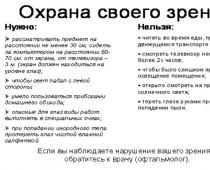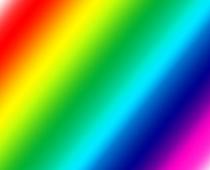Goals:
- Consider the features of lenses and their practical application using
- visual, demonstration and laboratory equipment.
- To develop the educational and cognitive activity of students through the change of forms of work.
- Using the examples of historical inventions of optical devices, their vital importance to cultivate curiosity and interest in the subject.
Equipment:
- TSO: presentation on the topic ( Annex 1 )
- Optical devices (microscope, camera, magnifier, etc.), eye model.
- Laboratory equipment (lenses, incandescent lamps, current sources, screens)
DURING THE CLASSES
1. Check homework
Answer the questions:
a) What phenomenon is called refraction?
b) What is the law of light refraction?
c) What is the physical meaning of the index of refraction?
Right answers:
a) On the border of two media light changes its direction of propagation. If the second medium is transparent, then the light can partially pass through the border of the medium, changing the direction of propagation. This phenomenon is called refraction.
b) The incident ray, the refracted ray and the normal to the interface between two media at the point of incidence lie in the same plane. The ratio of the sine of the angle of incidence to the sine of the angle of refraction is a constant value for these two media, equal to the relative refractive index of the second medium relative to the first.
c) The refractive index is equal to the ratio of the speeds of light in media, on the border between which refraction occurs:
2. Actualization of knowledge
Not all the bodies we can examine in detail, bringing them closer to the eye. There are objects that we cannot even bring closer (for example, celestial bodies) or they are so small that it is impossible to see them. In such cases, optical systems are used. The main part of them is the lens.
3. Explanation of the material
Definitions:
A transparent body bounded by spherical surfaces is called lens.
The lens can be bounded by two convex surfaces (biconvex lens), a convex spherical surface and a plane (plane-convex), convex and concave spherical surfaces (concave-convex lens). These lenses are thicker in the middle than at the edges, and they are all called convexthey are collecting. Lenses that are thinner in the middle than the edges are called concave. Accordingly: biconcave, flat-concave, convex-concave, they are scattering.
If the lens thickness is negligible compared to the radii of the spherical surfaces of the lens and the distance from the object to the lens, then such lenses are called thin.
The main points and lines for building the image in the lens:
The vertices of the spherical segments are located in a thin lens so close to each other that they can be taken for one point, which is called optical center of the lens.The straight line passing through the centers of spherical surfaces that limit the lens is called main optical axis. Any other straight line passing through the optical center is called side optical axis. The point at which, after refraction in the collecting lens, the rays incident on it parallel to the main optical axis intersect is called the main focus of the lens.The lens has a two-pronged focus. They are located on both sides of the lens at equal distances from it. These distances are called lens focal length.
Lens specifications
Lens focal lengthstand for the letter F.The inverse focal distance is called optical power lensesand denoted by a letter D:
D = 1 \\ F.
If D\u003e 0, the lens is collecting,
if D< 0, линза рассеивающая.
The optical power of the lenses is expressed in diotriae (diopter). The optical power of 1 diopter has a lens with a focal length of 1 m.
The use of lenses. Optical instruments
Background material on the history of inventions.
Microscope: at the end of the 16th century the Dutchman Hans Jansen invented the first microscope
In 1665 English scientist Robert Hooke (1635-1703) invented the microscope, which gives a clearer image.
Telescope: In 1592, the Italian scientist Galileo Galilei (1564-1642) constructed a telescope that magnified objects 30 times and observed the Moon and the movement of the planets.
In 1668 English scientist Isaac Newton (1642-1727) created a new type of telescope, he used mirrors and lenses to focus the rays of the observed objects, thus reducing the distortion associated with defects in lenses.
Camera:made the first photograph in the world in 1826 French physicist Joseph Nieppe (1765-1833). The American inventor George Eastman (1854-1932) created the Kodak hand-held camera, it was sold along with a roll of film. The camera "Polaroid" was invented in 1947 by the American Edwin Lend (1909-1991). The first Polaroid cameras for color photographs were created in 1963.
Points:v1280g Italian physicist Salvino degli Armati (1245-1317) made the first points.
Contact lenses:a native of Florence, Leonardo da Vinci (1452-1519) put forward the idea of contact lenses. In the Codex about the Eye, he describes a tube with lenses inserted at both ends, filled with water and intended for vision correction.
In the 18th century, the idea of Leonardo was put into practice by Thomas Jung and John Herschel (the son of William Herschel). A layer of transparent gel was applied to Herschel’s eye, which made it possible to eliminate the visual defect.
Modern optical devices
Demonstration devices:microscope, telescope, camera, binoculars, magnifier, glasses, contact lenses.
Eye - optical system
The human eye is almost spherical in shape. The diameter of the eye is 2.4 cm. The dense outer shell of white color that protects the eye and gives it a permanent shape is called the sclera. The front of the sclera enters a transparent, slightly convex cornea, which acts as a collecting lens and provides 75% focusing ability. Behind the pupil is the lens - a transparent body that looks like a lens. The lens, by means of muscles fastened to it, reflexively changes its curvature. As a result, when an object approaches or moves away from the eye, the image of the object at the bottom of the eye (retina) remains clear.
When vision deteriorates, the lens is often broken: it loses its elasticity and partly the ability to change its curvature. If the lens is too convex in comparison with the lens of a normal eye, then the eye doesn’t see faraway objects, myopia occurs. If the lens becomes too flat compared with the lens of a normal eye, then the person does not clearly see close objects. This is a sign of farsightedness. In such cases, you have to wear one glasses with concave glasses, and the other - with convex. Instead of glasses, contact lenses are sometimes used, made of a special transparent plastic.
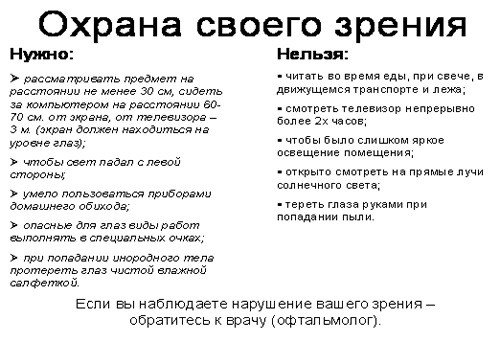
4. Fastening the material
Practical work
Determination of the focal length and optical power of the collecting lens.
Equipment: collecting lens, incandescent lamp, current source, screen, ruler.
The simplest way to measure the focal length and optical power of a lens is based on the use of a lens formula:
1 \\ d + 1 \\ f = 1 \\ F = D
With a lamp, lens and screen at certain distances, take measurements. On the screen to get a real magnified or valid thumbnail image of the filament lamp. (d is the distance from the lamp to the lens, f is the distance from the lens to the screen).
When calculating the focal length, take into account the unit of measurement (convert units into meters), then the optical power will be expressed in diotries.
Lesson summary
The main characteristic of the lens is optical power. To build an image, you can use two of the three "convenient" rays. Lenses are the main part of optical devices. In the eye, too, there is a lens - the lens.
5. Homework:§§ 63-65, pp. 186-193 (textbook 11 cl . G.Ya. Myakishev, B. B. Bukhovtsev, V. M. Charugin; Moscow "Enlightenment" 2010).
Send your good work in the knowledge base is simple. Use the form below.
Students, graduate students, young scientists who use the knowledge base in their studies and work will be very grateful to you.
Posted at http://www.allbest.ru/
Lenses and their types
A lens is a transparent body, bounded by two curvilinear (most often spherical) or curvilinear and flat surfaces. Lenses are divided into convex and concave.
Lenses whose middle is thicker than the edges are called convex. Lenses whose middle is thinner than the edges are called concave.
If the refractive index of the lens is greater than the refractive index of the environment, then in a convex lens a parallel beam of rays after refraction is converted into a converging beam. Such lenses are called collecting (Fig. 89, a). If a parallel beam in the lens is converted into a diverging beam, then these lenses are called scattering (Fig. 89 b). Concave lenses, in which air serves as the external medium, are diffusing.
O 1, O 2 - the geometric centers of the spherical surfaces bounding the lens. The straight line О 1 О 2 connecting the centers of these spherical surfaces is called the main optical axis. We usually consider thin lenses whose thickness is small compared to the radii of curvature of its surfaces, therefore the points C 1 and C 2 (the tops of the segments) lie close to each other, they can be replaced by a single point O, called the optical center of the lens (see. 89a). Any straight line drawn through the optical center of the lens at an angle to the main optical axis is called the secondary optical axis (A 1 A 2 B 1 B 2).
If a beam of rays parallel to the main optical axis falls on the collecting lens, then after refraction in the lens they are collected at one point F, which is called the main focus of the lens (Fig. 90, a).
The continuation of the rays that, before refraction, were parallel to its main optical axis, intersect at the focus of the scattering lens (Fig. 90, b). The focus of the lens is imaginary. The main tricks are two; they are located on the main optical axis at the same distance from the optical center of the lens on opposite sides.
The magnitude inverse of the focal length of the lens is called its optical power. The optical power of the lens - D.
For the unit of optical power of the lens in the SI take diopters. Diopter - the optical power of the lens, the focal length of which is 1 m.
The optical power of the collecting lens is positive, dissipating - negative.
The plane passing through the main focus of the lens perpendicular to the main optical axis is called the focal (Fig. 91). A beam of rays incident on the lens parallel to any secondary optical axis is collected at the point of intersection of this axis with the focal plane.
Constructing an image of a point and an object in a collecting lens.
To construct an image in the lens, it is enough to take two beams from each point of the object and find their intersection point after refraction in the lens. It is convenient to use the rays, the course of which after refraction in the lens is known. Thus, the beam incident on the lens parallel to the main optical axis, after refraction in the lens, passes through the main focus; the beam passing through the optical center of the lens is not refracted; the beam passing through the main focus of the lens, after refraction, is parallel to the main optical axis; the beam incident on the lens parallel to the secondary optical axis, after refraction in the lens, passes through the point of intersection of the axis with the focal plane.
Let the luminous point S lies on the main optical axis.
convex concave radar lens
We choose an arbitrarily beam and parallel to it we carry out a secondary optical axis (Fig. 92). The selected beam after refraction in the lens will pass through the point of intersection of the secondary optical axis with the focal plane. The point of intersection of this beam with the main optical axis (the second beam) will give a real image of the point S - S`.
Consider building an image of an object in a convex lens.
Let the point lie outside the main optical axis, then the image S` can be constructed using any two rays shown in Fig. 93.
If the object is located at infinity, then the rays intersect at the focus (Fig. 94).
If the object is located behind the point of double focus, then the image will be real, reverse, reduced (camera, eye) (Fig. 95).
If the object is located at a double focus point, then the image will be real, inverse, equal to the object (Fig. 96).
If the object is located between the focus and the point of double focus, the image will be real, reverse, enlarged (photographic enlarger, movie camera, film viewer) (Fig. 97).
If the subject is in focus, the image will be at infinity (there will be no image) (fig. 98).
If the object is located between the focus and the optical center of the lens, the image will be imaginary, straight, enlarged (magnifying glass) (Fig. 99).
At any distance from the object to the diffusing lens, it gives an imaginary, direct, reduced image (Fig. 100).
Depending on the forms distinguish gathering (positive) and scattering(negative) lenses. The group of collecting lenses is usually attributed to the lens, in which the middle is thicker than their edges, and the group of diffusing lenses - the lens, the edges of which are thicker than the middle. It should be noted that this is true only if the refractive index of the lens material is greater than that of the environment. If the refractive index of the lens is less, the situation will be reversed. For example, a bubble of air in water is a biconvex diffusing lens.
Lenses are characterized, as a rule, by their optical power (measured in diopters) and focal length.
For the construction of optical devices with corrected optical aberration (primarily chromatic, due to light dispersion, achromates and apochromates), other properties of lenses and their materials are important, for example, the refractive index, dispersion coefficient, and the transmittance of the material in the selected optical range.
Sometimes lenses / lens optical systems (refractors) are specifically designed for use in media with a relatively high refractive index (see immersion microscope, immersion liquids).
Types of lenses:
Gathering:
1 - biconvex
2 - convex-flat
3 - convex-concave (positive (convex) meniscus)
Scattering:
4 - biconcave
5 - flat-concave
6 - convex-concave (negative (concave) meniscus)
The convex-concave lens is called meniscus and it can be collective (thickens towards the middle), diffusing (thickens towards the edges) or telescopic (focal length equals infinity). So, for example, lens glasses for myopic - as a rule, negative menisci.
Contrary to common misconception, the optical power of the meniscus with the same radius is not zero, but positive, and depends on the refractive index of the glass and on the thickness of the lens. A meniscus whose surface curvature centers are at one point is called a concentric lens (optical power is always negative).
A distinctive feature of the collecting lens is the ability to collect the rays falling on its surface at one point located on the other side of the lens.
Application
Lenses are the universal optical element of most optical systems.
The traditional use of lenses - binoculars, telescopes, telescopic sights, theodolites, microscopes and photovideo technology. Single collecting lenses are used as magnifying glasses.
Another important field of application of lenses is ophthalmology, where without them it is impossible to correct visual deficiencies - myopia, hyperopia, improper accommodation, astigmatism and other diseases. Lenses are used in devices such as glasses and contact lenses.
In radio astronomy and radar, dielectric lenses are often used that collect the flow of radio waves into the receiving antenna or focus on the target.
In the design of plutonium nuclear bombs to convert a spherical diverging shock wave from a point source (detonator) into a spherical converging lens systems made of explosives with different detonation speeds (that is, with different refractive index) were used.
Posted on Allbest.ru
Similar documents
Classification and types of polymers, their general characteristics and spheres of practical application, properties: mechanical, thermal, chemical, electrical, technological. Types of polyimides produced by Fujifilm, heat treatment requirements.
thesis, added 26.03.2015
Development of the design of an axisymmetric magnetic lens for electrons. Determination of the cross section of the magnetic circuit, the method of thermal calculation. The choice of the design of the lens, the calculation of the thickness of iron necessary to provide it with a given magnetic induction.
examination, added 10/4/2013
The essence of the lens, the classification of its convex (collecting) and concave (scattering) forms. The concept of lens focus and focal length. Features of the construction of the image in the lens, depending on the path of the beam after its refraction and the location of the object.
presentation added on 02/22/2012
Types of solar collectors: flat, vacuum and air. Their design, principle of operation, advantages and disadvantages, application. Household collector device. Solar towers. Parabolic cylinders and parabolic concentrators. Fresnel lenses.
abstract, added on 03/18/2015
The classical theory of vibrational spectra and their quantum-mechanical representation. The principle of operation and the internal structure of infrared spectrometers, their classification and types, functional features, conditions and areas of practical application.
term paper added on 01/21/2017
Elementary theory of thin lenses. Determination of the focal length of the magnitude of the object and its image and the distance of the latter from the lens. Determination of the focal length of the magnitude of the movement of the lens. Lens magnification ratio.
laboratory work, added on 07.03.2007
The essence and physical substantiation of the phenomenon of holography as the restoration of the image of the object. Properties of sources: coherence, polarization, wavelength of light. Classification and types of holography, the scope of practical application of this phenomenon, technology.
abstract, added 11.06.2013
Overview of the refraction and reflection of light on spherical surfaces. Determining the position of the main focus of the refracting surface. Descriptions of thin spherical lenses. Formula thin lenses. Imaging objects with a thin lens.
abstract, added 04/10/2013
Convection as the transfer of energy by jets of liquid or gas, its laws and significance. Spheres and directions of practical application of this phenomenon, and the main factors affecting its intensity. Classification, types and mechanisms of convection.
presentation added on 04/14/2011
The essence and types of thermal converters, the principle of their actions and purpose, the scope of practical use, manufacturing steps. Characteristic of standard common types of thermocouple connection to measuring and conversion devices.
11.2. Geometrical optics
11.2.4. Lens application
The use of collecting and scattering lenses in some optical devices
Collecting and diffusing lenses are used in some optical devices that are used in everyday life.
When using the camera:
- the item is placed at a distance of d\u003e 2F;
- the image is formed at a distance F< f < 2F ;
- a photographic film or photographic plate is placed in the place where the image is formed.
The image obtained using the camera is valid, reduced, inverted. The camera uses collecting lenses.
When using a magnifying glass, it is positioned so that:
- the object was between the lens and its focus d< F ;
- the image is formed behind the focus f\u003e F.
The image obtained with a magnifying glass is imaginary, enlarged, direct. Magnifier is a collecting lens with a small focal length.
The use of glasses is associated with vision correction. In the correction of farsightedness use collecting lenses, myopia - scattering:
- hyperopia corrected by a lens with a positive optical power (collecting lens)
ΔD = D 0 - D\u003e 0,
where D 0 = 1 / F 0; F 0 - the distance of the best vision of a normal eye, F 0 = d 0 = 25 cm; D = 1 / F; F - distance of the best sight of a far-sighted person, F = d; d\u003e d 0;
- myopia is corrected by a lens with a negative optical power (diffusing lens)
ΔD = D 0 - D< 0,
where d = 1 / f; F is the distance of the best vision of a myopic person, F = d; d< d 0 .
Example 17. The camera lens has a focal length of 60 cm. The shooting is carried out from an airplane flying at an altitude of 2.0 km. The dimensions of the film in the camera are 15 × 15 cm. Find the surface area of the Earth, which can be fixed in one picture.
Decision . The linear size of the image of the Earth's surface on film coincides with the linear size of the film itself:
a = H,
where a = 15 cm.
The sought value is the surface area of the Earth:
S = b 2,
where b is the linear size of the photographed area of the Earth (the linear size of the object), b = h.
The linear magnification of the camera lens is determined by the ratio
G = H h = a b = f d,
where f is the distance from the lens to the image (to the film); d is the distance from the object to the camera lens (approximately coincides with the height of the aircraft above the surface of the Earth), d = 2.0 km.
To obtain an image in a camera using a collecting lens; the image received with its help is valid. The values of d and f are interconnected by the thin collecting lens formula:
1 F = 1 d + 1 f,
where F is the focal length of the lens, F = 60 cm.
Find from here the value of f:
f = F d d - F
and substitute it into equality
a b = f d = F d - F.
Express the linear size of the earth’s surface:
b = a (d - F) F = a d F,
since d \u003e\u003e f.
The maximum area that can be photographed from an airplane is determined by the formula
S = (a d F) 2.
Calculate:
S = (15 ⋅ 10 - 2 ⋅ 2.0 ⋅ 10 3 60 10 - 2) 2 = 0.25 10 6 m 2 = 0.25 km 2.
Example 18. The distance of the best vision of a healthy human eye is 25 cm. For a myopic person, it is 10 cm. Find the optical power of the lenses of the glasses necessary for correcting vision.
Decision . For the correction of myopia use scattering lenses, optical power which is determined by the formula
ΔD = D 0 - D< 0,
where D 0 = 1 / F 0; F 0 - the distance of the best vision of a healthy human eye, F 0 = d 0 = 25 cm; D = 1 / F; F - the distance of the best vision of a myopic person, F = d = 10 cm ;.
We write the formula explicitly
Δ D = 1 d 0 - 1 d.
Calculate:
Δ D = 1 25 ⋅ 10 - 2 - 1 10 ⋅ 10 - 2 = 4.0 - 10 = - 6.0 dptr.
Vision correction requires glasses with diffusing lenses, the optical power of which is −6.0 diopters.
Formula thin lens as applied to converging beams of light
A beam of light, having the form of a cone, the rays of which, in the absence of obstacles converge at its top, is called converging. If a converging beam of light falls on the lens, the formula of both the collecting and the diffusing thin lens is written differently.
converging beam of light onto a thin converging lens shown in fig. 11.37. The light rays in the figure are shown as a solid line, the continuation of the light rays is dotted:
Formula thin converging lens for converging beam
1 F = - 1 d + 1 f,
where F is the focal length of the collecting lens; d is the distance from point S to the lens (distance | OS |); f is the distance from the lens to the point S * (distance | OS * |).
For a collecting lens, the distance d is always greater than the distance f: d\u003e f, since after refraction in the collecting lens, the rays converge closer to the lens than they would if it were not present.
The course of light rays in the fall converging beam of light onto a thin diffusing lens shown in fig. 11.38. The light rays in the figure are shown by a solid line, the continuation of the light rays is dotted:
- the imaginary source of light is the point S, at which the continuations of the light rays converge;
- the actual image is the point S * at which the rays converge after refraction in the lens.
Formula thin diverging lens for converging beam The light is written as follows:
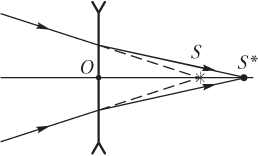
Fig. 11.38
- 1 | F | = - 1 d + 1 f,
where F is the focal length of the diffusing lens; d is the distance from point S to the lens (distance | OS |), d = | OS |; f is the distance from the lens to the point S * (distance | OS * |), f = | OS * |.
For a diffusing lens, the distance d is always less than the distance f: d< f , так как после преломления в рассеивающей линзе лучи сходятся дальше от линзы, чем сошлись бы при ее отсутствии.
The right side of the thin lens formula for converging beams of light has the same appearance for a converging and diffusing lens:
- in both cases is formed real image (the point S * in which the rays themselves really converge), therefore the sign in front of the 1 / f term in the lens formula is always positive;
- in both cases light source is imaginary (the point S, at which the continuations of the rays converge), therefore the sign in front of the term 1 / d in the lens formula is always negative.
The left part of the thin lens formula for converging light beams is written in the traditional form (1 / F for the collecting lens, (−1 / | F |) for the diffusing).
Example 19. A converging beam of light falls on a diffusing lens. After refraction in the lens, the rays converge at a distance of 75 cm from its optical center, and the continuation of the rays at a distance of 30 cm. Find the optical power of the lens.
Decision . In the figure, the light rays are shown as a solid line; continuation of the light rays - dotted.

An imaginary source of light is the point S, at which the continuations of the light rays converge. The actual image is the point S * at which the rays converge after refraction in the lens.
For a converging beam of light, the formula for a thin diverging lens is as follows:
D = - 1 d + 1 f,
where D is the optical power of the lens (the desired value); d is the distance from point S to the lens, d = 30 cm; f - the distance from the lens to the point S *, f = 75 cm.
The calculation gives the value
D = - 1 30 ⋅ 10 - 2 + 1 75 10 - 2 = - 2.0 diopters.
The optical power of this lens is -2.0 diopters.
The lens is a transparent body that is bounded by two spherical surfaces. The main property of lenses is the ability to give images of objects. They can be imaginary and real, inverted and straight, reduced and enlarged. The linear dimensions of the image vary depending on the location of objects.
Magnification lens - the ratio of the linear dimensions of the image and subject. The magnification factor (K) can be expressed by the formula: K = u / v, where u is the distance from the lens to the object, and v is the distance from the lens to the image. The magnification factor is an indicator of how much the linear dimensions of the subject are larger or smaller than the dimensions of the image.
In science, there are concepts such as a collecting lens and a diffusing. The first is thicker in the middle, and thinner at the edge, while the second is the opposite. Lenses are characterized by a focal length (from the optical center to the focus: it is negative for a diverging lens, and positive for a collecting lens) and optical power, which is measured in diopters. one diopter is 1 meter. The optical power depends on the radii of curvature of the spherical surfaces of the lens, as well as the material (its refractive index) from which it is made. It is the inverse of the focal length.
The collecting lens has the following differences from the diffusing lens:
The collecting lens can be directed to the object by any side, and the rays will be collected at the same time, since such a lens has 2 focus. On the optical axis, the front and rear foci are located on both its sides at a focal distance from the main points of the lens.
Lens materials
Collects the light.
The edges are thinner than the middle.
It is a collection of a large number of triangular prisms expanding toward the middle of the lens (and not towards the edges).
The focus of the lens (that is, the point of intersection of the rays after refraction, located on the main optical axis) is real (and not imaginary), because the rays themselves intersect, not their continuation.
Able to collect rays falling on the surface at one point, which is located on the other side of the lens.
0 or imaginary f 2) Increased G 0, reduced G 3) Direct or inverse (inverted) "width =" 640 "
Types of lenses
Picture
1) Real f 0 or imaginary f
2) Increased G 0, reduced G
3) Forward or reverse (inverted)



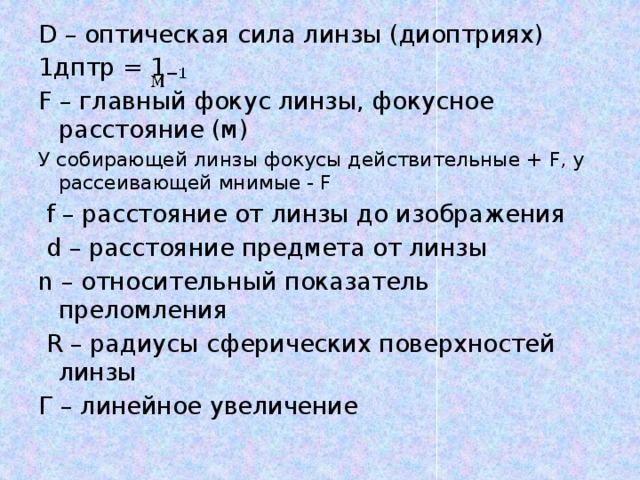
D - the optical power of the lens (diopters)
F - main focus of the lens, focal length (m)
The collecting lens focuses real + F, the scattering imaginary - F
f - the distance from the lens to the image
d is the distance of the object from the lens
n is the relative refractive index
R - the radii of the spherical surfaces of the lens
G - linear increase

Types of lenses
A light-transparent body bounded by convex or concave refractive surfaces is called a lens.
1 - biconvex
2 - flat convex
3 - convex-concave
4 - concave-convex
5 - biconcave
- - flat-concave
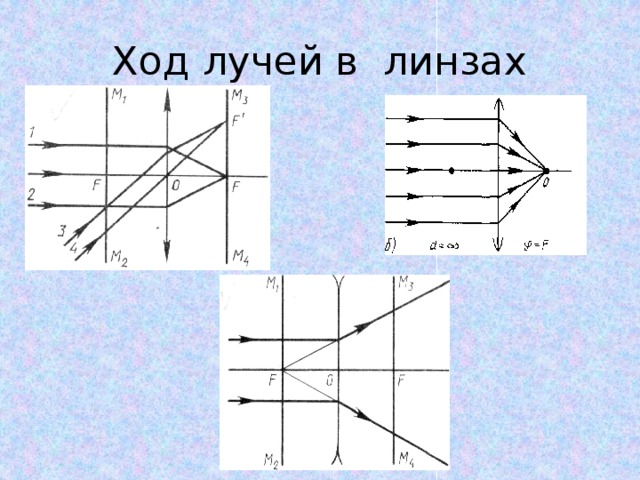
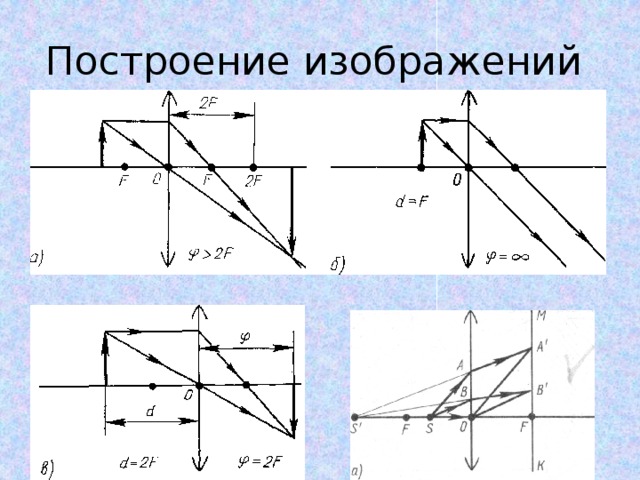
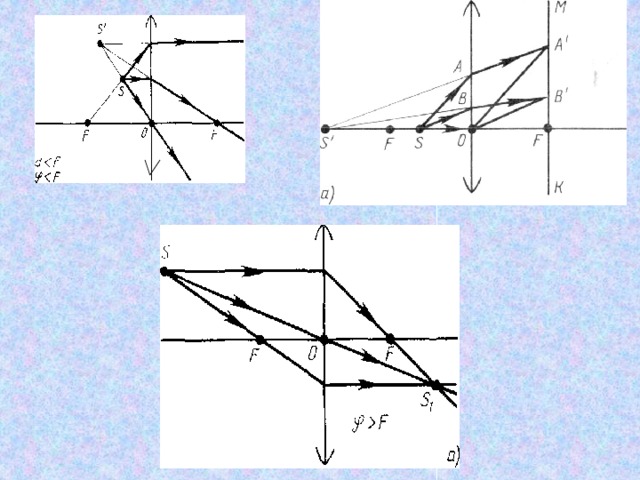
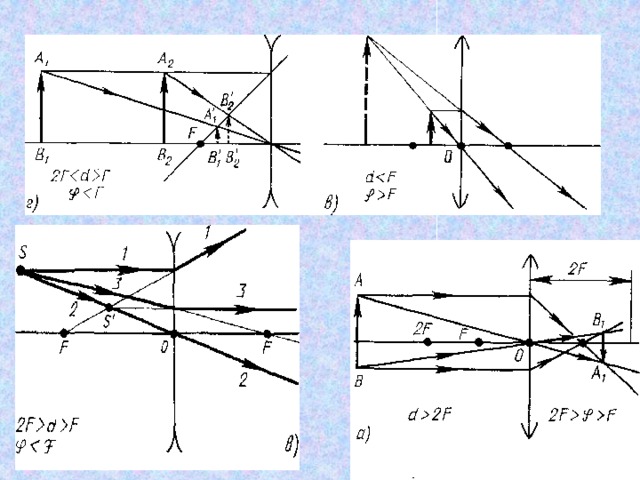

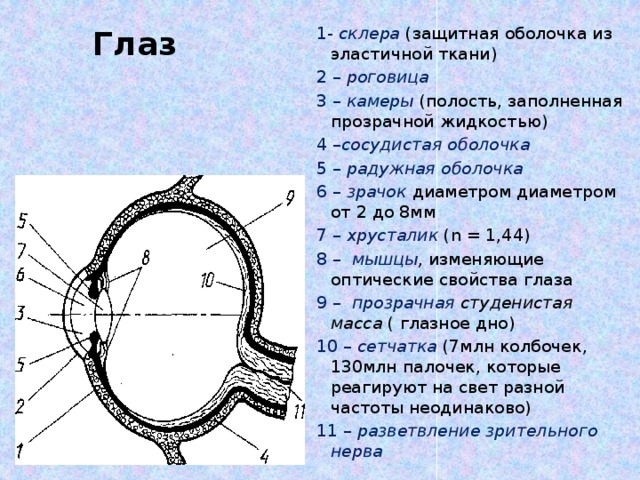
Eye
1- sclera (protective sheath of elastic fabric)
2 – cornea
3 – cameras (cavity filled with clear liquid)
4 – vascular shell
5 – iris
6 – pupil diameter from 2 to 8mm
7 – lens (n = 1.44)
8 – muscles , changing the optical properties of the eye
9 – transparent gelatinous mass (ocular fundus)
10 – retina (7 million cones, 130 million rods that react to light of different frequencies differently)
11 – branching of the optic nerve
Eye – This is a 90% information lens system. Diameter of eye ̴23mm
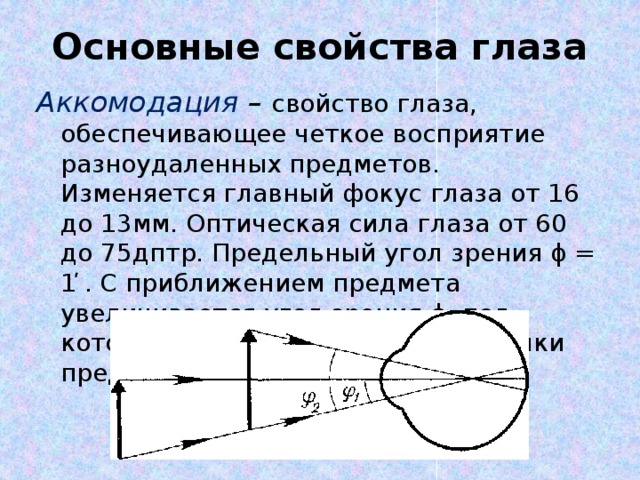
The main properties of the eye
Accommodation – property of the eye, providing a clear perception of multi-distant objects. The main focus of the eye changes from 16 to 13mm. Optical power of an eye from 60 to 75dptr. The limiting angle of view is ϕ = 1̕. As the object approaches, the angle of view ϕ increases, under which we see two close points of the object
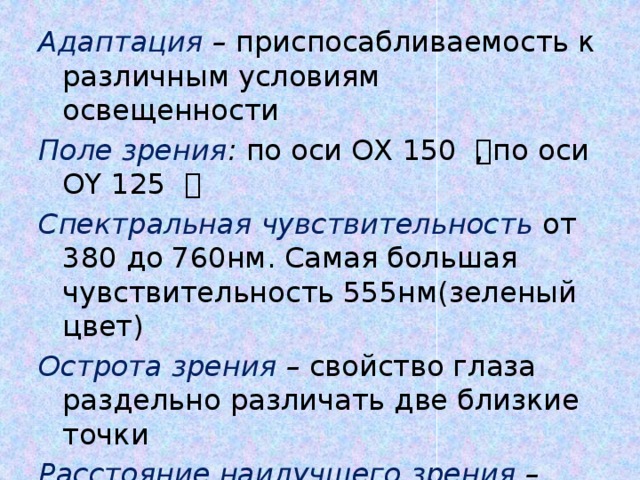
Adaptation – adaptability to different lighting conditions
line of sight : on axis ΟΧ 150 ͦ, on axis Оͦ 125 ͦ
Spectral sensitivity from 380 to 760nm. The biggest sensitivity is 555nm (green)
Visual acuity – property of the eye to distinguish two close points separately
Best vision distance – 250mm. Eye sees distant objects without tension.
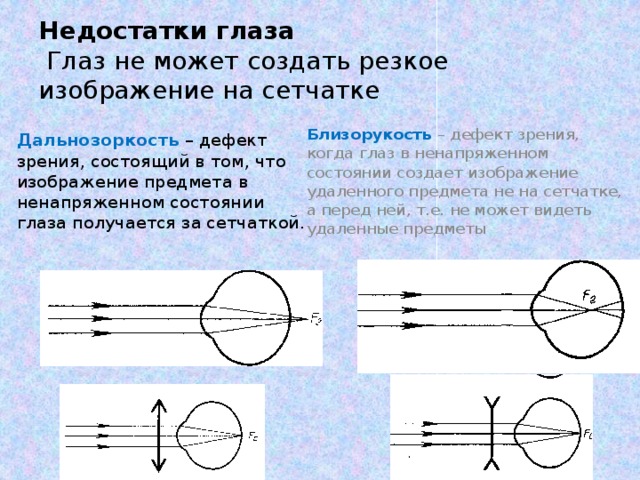
Eye flaws The eye can not create a sharp image on the retina
Farsightedness - visual defect, consisting in the fact that the image of the object in the relaxed state of the eye is obtained behind the retina.
Myopia - visual impairment, when the eye in the relaxed state creates an image of a remote object not in the retina, but in front of it, i.e. can't see deleted items
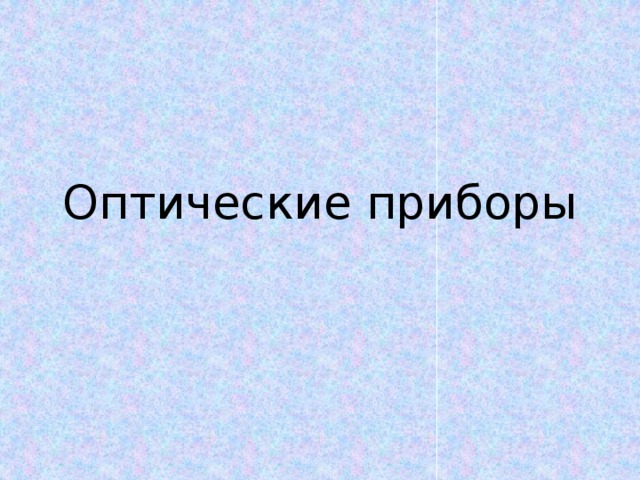
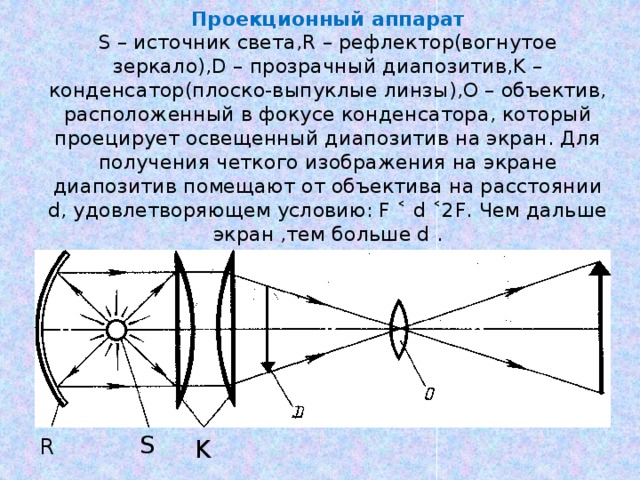
Projection apparatus S is a light source, R is a reflector (concave mirror), D is a transparent transparency, K is a condenser (flat convex lenses), O is a lens located in the focus of the condenser that projects the illuminated transparency onto the screen. To obtain a clear image on the screen, a transparency is placed at the distance d from the lens, satisfying the condition: F ˂ d 2F. The farther the screen, the more d.
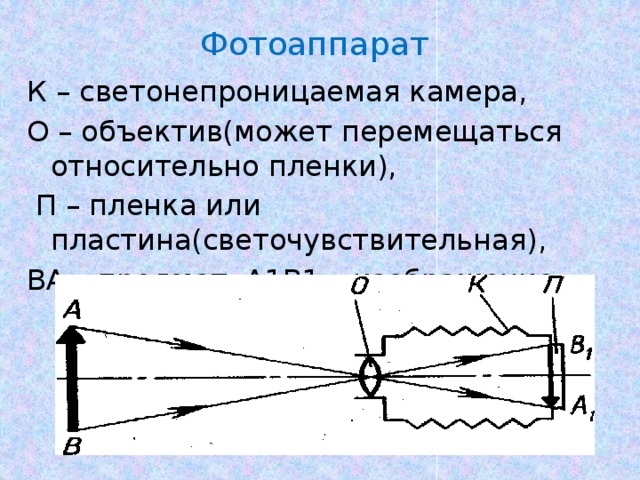
Camera
K - lightproof camera,
O - lens (can move relative to the film),
P - film or plate (photosensitive),
VA - subject, A1B1 - image.
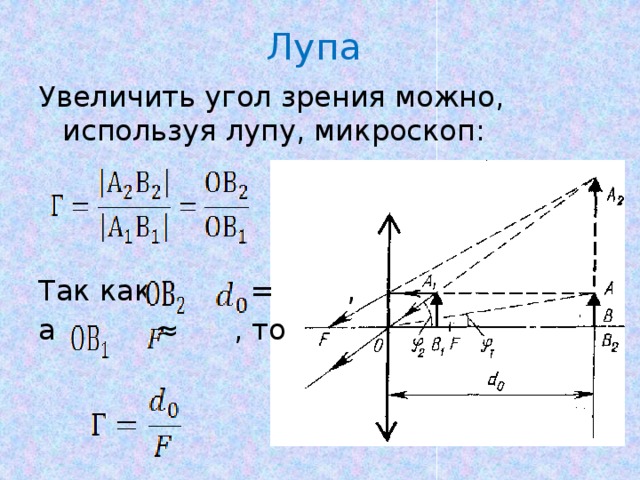
To increase the angle of view using a magnifying glass microscope:
Since =,
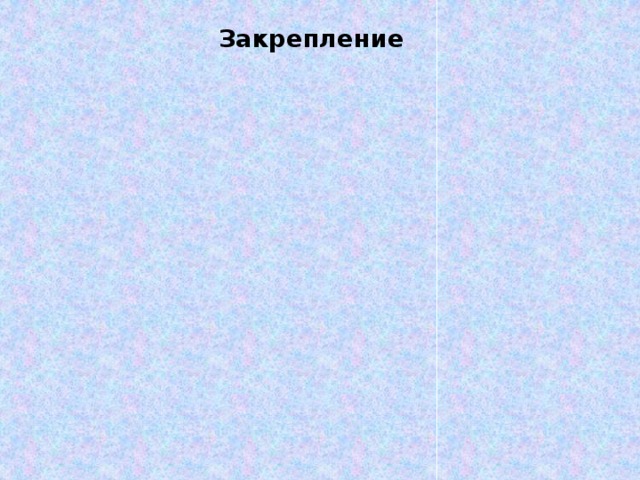
- In contact with 0
- Google+ 0
- OK 0
- Facebook 0



